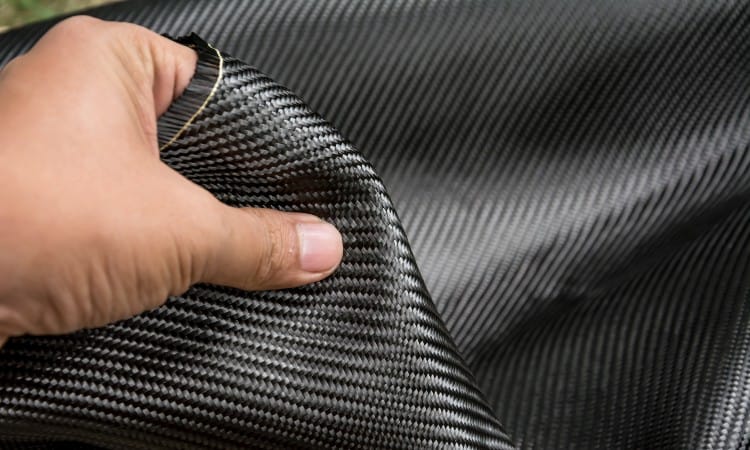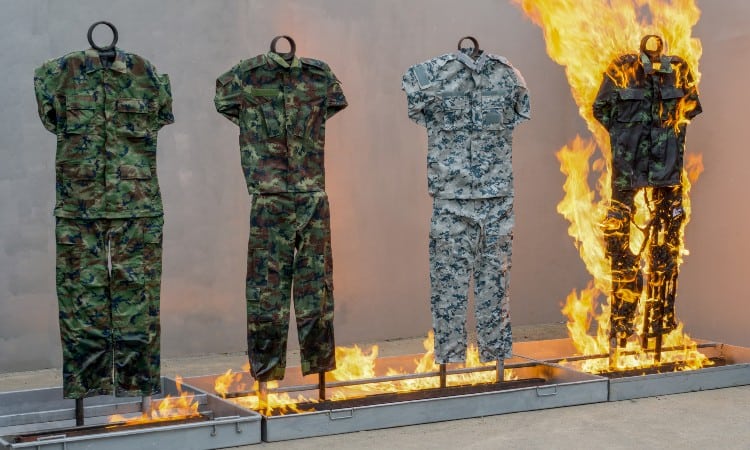There are a lot of different fabric types out there. One such group of fabrics, known as technical fabrics, are a bit different from the fabrics you and I may be used to. You may even be wondering, “What is technical fabric anyway?”
Technical fabrics are fabrics that were created to serve a specific purpose. They aren’t always the most aesthetic, but they are functional and usually made of synthetic fibers to increase functionality. Specific examples of technical fabrics include Gore-Tex, Kevlar, and even specialized versions of polyester and nylon, among others.
But how exactly are technical fabrics different from the fabrics that we’re used to? What are they made of and how are they made? What functions do they serve? In this article, I’ll try to answer any questions that you may have regarding technical fabric.

What is Technical Fabric?
Technical fabric is any fabric that was created for a specific function. Because these fabrics are designed to be functional, they aren’t always the “prettiest” fabrics. Overall, technical fabrics are designed to be durable, but they all don’t necessarily have the same characteristics and design. Rather, the design depends on the function that they serve.
The most common use for technical fabrics is in sportswear, but they have other industrial uses. For example, you can find many technical fabrics in the medical and manufacturing fields, where they are used as personal protective equipment (PPE) for employees. Technical fabric can be found in various forms in different industries.
You may also hear technical fabrics referred to under different names. Some of these names include technical textiles, performance fabrics, and smart fabrics or textiles. Because these fabrics have so many different uses and characteristics based on those uses, there are many different terms used to describe the characteristics of these fabrics as well.
What is the Purpose of Technical Fabric?

The overall purpose of a technical fabric is function. But different technical fabrics have different specific functions, and the fabric is designed around that function. For example, some technical fabrics are stretchy, some are waterproof, and some are stretchy and waterproof. It just depends on what specific purpose the fabric is used for.
There are 5 groups of technical fabrics that are the most popular because of the function they serve. Let’s look at each of these 5 groups, their general purpose, and some of the characteristics of technical fabrics in each group.
Protective Textiles
One of the most important functions of a technical fabric is protection. While they aren’t necessarily geared toward industrial workers, other basic fabrics don’t offer very much protection for people that work in some of the more dangerous careers. Protective fabrics are necessary to keep them safe.
The design of protective technical textiles is centered around four main health and safety hazards. These fabrics are going to offer protection against at least one of these hazards:
- Ultraviolet radiation
- Temperature
- Impact
- Contamination
Ultraviolet Radiation
Technical fabrics that protect against ultraviolet radiation would mainly be worn by people who spend a lot of time working outdoors. These fabrics are going to offer more protection from the effects of the sun. You will also find fabrics that offer this type of protection in swimwear. And because they protect against UV radiation, a lot of these fabrics will be fade-resistant as well.
Temperature
People who work around extreme heat or an open flame would want protection against burns and heat damage. Some technical fabrics are designed to be flame-resistant or withstand temperatures up to a certain temperature. For example, Nomex fabric can withstand temperatures of around 700 degrees Fahrenheit. It is usually used in flight suits worn by pilots or astronauts to protect them in a fire or explosion.
Impact
Law enforcement and military members will want protection against the impact of debris or other blunt forces as the result of an explosion or attack. Durable and heavy-duty technical fabrics such as Kevlar and high-performance polyethylene were created for this purpose.
Contamination
Lastly, people who work with dangerous chemicals, in hazardous areas, or in other places where they come into contact with toxic substances will also want protection. Basic fabrics won’t protect the wearer from chemical spills, germs, or other potential hazards. Technical fabrics that are worn to prevent contamination are usually impenetrable to keep contaminants out.
Sportswear
Another common area to find technical fabrics is sportswear. Fabrics in this area are designed around control and comfort and include spandex, neoprene, and polyester, among others. Some of the main goals for technical fabrics in sports are breathability, moisture-wicking ability, odor control, anti-chafing, and stretchiness.
Medical Fabrics
While most technical fabrics are made from synthetic fibers, some are made from natural fibers. You’re likely to find these technical fabrics made from natural fibers in the medical field; however, some synthetic fibers like polyester are still used. Bandages, dressings, and even hospital gowns can be considered technical fabrics. Some of these fabrics are even hi-tech and can monitor vital signs for the true definition of “smart” fabric.
Mobile Textiles
Mobile textiles are fabrics that you would find in the transportation section, such as those used in cars, buses, airplanes, etc. The goal of mobile textiles is to help regulate temperature, protecting the battery and other electrical components of vehicles from getting too hot. These fabrics are mostly known as phase change materials.
Electronic Textiles
Electronic textiles are fabrics that have LEDs, batteries, or computers built into them. These devices allow the fabrics to change color, light up, and even monitor the temperature. They work by weaving conductive materials into normal textiles. This type of textile is becoming increasingly common in interior design and clothing.
Technical Fabric Examples
Now that we know some of the most common uses of technical fabrics let’s look at some specific examples. This is not an all-inclusive list, but it does cover some of the more widely known technical fabrics. For each example of technical fabric, I’ll also talk about some of the characteristics and what each fabric is used for.
Gore-Tex
 Gore-Tex is marketed as being a high-performance fabric that is incredibly durable and waterproof.
Gore-Tex is marketed as being a high-performance fabric that is incredibly durable and waterproof.
It was first created in the 1960s and designed for sports and outdoor activities, especially high-performance activities or those where you would need protection from snow, rain, or other moisture.
Gore-Tex fabric has a special membrane that contains over 9 billion pores. Because each of those pores is 20,000 times smaller than a water droplet, moisture cannot get through. But due to having so many pores, the fabric is also breathable and windproof.
You can see why it’s an ideal choice for hiking jackets, gloves, shoes, and more outdoor adventure wear.
Coolmax
 Coolmax fabric is made from a blend of synthetic polyester fibers.
Coolmax fabric is made from a blend of synthetic polyester fibers.
But what’s different from other polyester fabrics is that Coolmax fabrics are more moisture-wicking, so they will keep you more dry, cool, and comfortable than the polyester used for normal t-shirts, for example.
Coolmax fabrics are great for sportswear because they will draw moisture to the fabric’s surface, where it will evaporate quickly.
X-Static
X-Static is a nylon fabric bonded with 99.9% pure silver that reduces static and helps the fabric remain functional. Not only does the fabric prevent static electricity, but it also has natural antibacterial and odor-control properties that don’t diminish over time. Because of this, it is widely used in the medical field and for shoes and furniture.
Kevlar
 Kevlar is a synthetic fabric made by the DuPont corporation. The most recognized uses for Kevlar are in bulletproof vests due to having a tensile strength that is stronger than steel and high ballistic resistance.
Kevlar is a synthetic fabric made by the DuPont corporation. The most recognized uses for Kevlar are in bulletproof vests due to having a tensile strength that is stronger than steel and high ballistic resistance.
But, it is also tear-resistant and heat resistant, making it a popular choice for personal protective equipment such as welding gloves.
It even has electrical uses, giving strength and flexibility to fiber optic cables.
Nomex
 Nomex is also manufactured by the DuPont corporation and was first introduced in the 1960s. It is highly fire-resistant, so one of the most common uses is firefighting gear and flight suits.
Nomex is also manufactured by the DuPont corporation and was first introduced in the 1960s. It is highly fire-resistant, so one of the most common uses is firefighting gear and flight suits.
But Nomex also has a high electrical and chemical resistance, so it has many industrial uses.
One of these uses is for hot gas filtration to help manufacturing facilities reduce their emissions.
Neoprene
 Neoprene is a synthetic rubberized fabric mostly used in aquatic clothing but is also used in the automotive industry. Because it is made of synthetic rubber, it is more durable and water-resistant than natural rubber.
Neoprene is a synthetic rubberized fabric mostly used in aquatic clothing but is also used in the automotive industry. Because it is made of synthetic rubber, it is more durable and water-resistant than natural rubber.
It is also more resistant to oil and chemical solvents. Neoprene is a great insulator, which is why it is used for scuba gear and wetsuits.
It will keep you warm even in the coldest water. Its automotive uses include seat covers as well as belts and seals.
Rubberized Cotton
Most of the technical fabrics covered so far have been synthetic, but rubberized cotton is one exception. Rubberized cotton is a natural cotton fabric that is coated with either natural or synthetic rubber. Coating rubber with cotton gives it more durability and expands its uses to make it more waterproof. This type of cotton is used for raincoats and hats, crib sheets, and tarps. It is also frequently used in the automotive industry to make tires.
How Are Technical Fabrics Made?
Most technical fabrics are usually made with synthetic fibers. This is because synthetic fibers are more durable and long-lasting than natural fibers. Commonly used synthetic fibers in technical fabrics include polyester, nylon, and spandex.
However, sometimes natural fibers are blended with synthetic fibers to give the fabrics certain qualities. This could include things like cotton for increased breathability or wool for odor control.
With that being said, the exact fiber type and manufacturing process will vary based on the type of technical fabric being produced. That’s another reason why synthetic fibers are used. They can be engineered and woven in different ways to give a fabric certain characteristics.
Most synthetic fibers are made from petroleum, so they are essentially plastic. However, other chemicals are combined with petroleum to make different types of plastic fibers. And once the fibers are made, they can be woven in different ways to create characteristics that make a fabric more breathable or moisture-wicking. Sometimes, they are coated with chemicals to make them stain, chemical, or flame-resistant as well.
For example, Kevlar and Nomex are both made of synthetic fiber known as polyamide. But the polyamide fibers are slightly different in how they are made and woven together and what they are coated with. Some technical fabrics like Coolmax and X-Static are made from standard nylon or polyester fabric.
Ultimately with technical fabrics, what they are made of is key. Since the fabrics are designed to be functional, they need to be made out of materials that best serve those functions and give them certain characteristics.
What Are the Properties of Technical Fabric?

While certain properties are specific to certain fabric types, there are some general characteristics that all technical fabrics share. For starters, technical fabrics are durable because they need to serve their purpose and hold up over time. That’s why they are made with mostly synthetic fibers.
Other general properties of technical fabrics are that they are moisture-wicking and resistant to wrinkles and shrinking. This is due to their plastic composition. They are also very easy to care for because they are generally resistant to stains and aren’t considered delicate by any means.
However, being made from plastic does have its downsides. Except for fabrics like Kevlar and Nomex that are capable of withstanding extreme temperatures, most fabrics made from synthetic fibers can’t tolerate heat and will melt quite easily. That’s why using the right type of fabric for its intended purpose is so important.
What Are the Advantages of Technical Fabric?
We’ve already covered many of the advantages of various synthetic fabrics, so here is just a very brief review. First of all, technical fabrics are very versatile since they are made from synthetic fibers. One type of fabric can have a lot of different uses.
But the reason that there are so many different types of technical fabrics is that synthetic fibers can be engineered to have different characteristics to meet certain needs. Some technical fabrics are more breathable than others, while some are more heat resistant.
In general, though, all technical fabrics are very durable, functional, and easy to care for. But since many of them are created by a specific individual and specialized company, you can be assured that whatever fabric you choose will serve its purpose well, whatever that purpose may be.
What Are the Disadvantages of Technical Fabric?
Despite the many advantages of technical fabric, there are some disadvantages as well. For starters, you may not find a wide selection of certain fabric types since they aren’t designed for aesthetic appeal. Some of them may not even be available to purchase by the average consumer.
Another disadvantage is that although certain technical fabrics are designed to be breathable, they likely won’t be as breathable as natural fibers like cotton and wool. That’s why natural fibers are sometimes woven into technical fabrics along with synthetic fibers. This is done to enhance breathability and give certain fabrics more ideal characteristics.
Finally, most technical fabrics are not eco-friendly since they are made from synthetic fibers. The petroleum that they are made of is a non-renewable resource that comes from crude oil. Using petroleum and other chemicals to manufacture fabrics can lead to pollution and other environmental issues.
Some companies are trying to reduce pollution, but as long as technical fabrics are made from synthetic fibers, they will never be truly environmentally friendly. This also poses other problems because the fabrics would lose some of their ideal qualities if synthetic fabrics aren’t used. There’s not a clear solution to this problem.
What Is A High Tech Fabric?
High-tech fabrics are fabrics that are made using innovations and technologies in the fashion world. Some high-tech fabrics can be smart fabrics, such as those used in the medical field that help to monitor vital signs. But the term can also be used to refer to fabrics made using a new type of weave that gives it more favorable characteristics. Most technical fabrics are going to be high-tech fabrics because they were made using new technologies and innovations.
Conclusion
Technical fabrics are fabrics that are designed for function rather than appearance. Most of these fabrics are made to protect the wearer, such as in the workplace, medical field, or even in sports. Technical fabrics have characteristics that support their function, so they are usually made with synthetic fibers that can be engineered differently. If you found this article informative, share it with others and leave a comment. Thank you for reading!